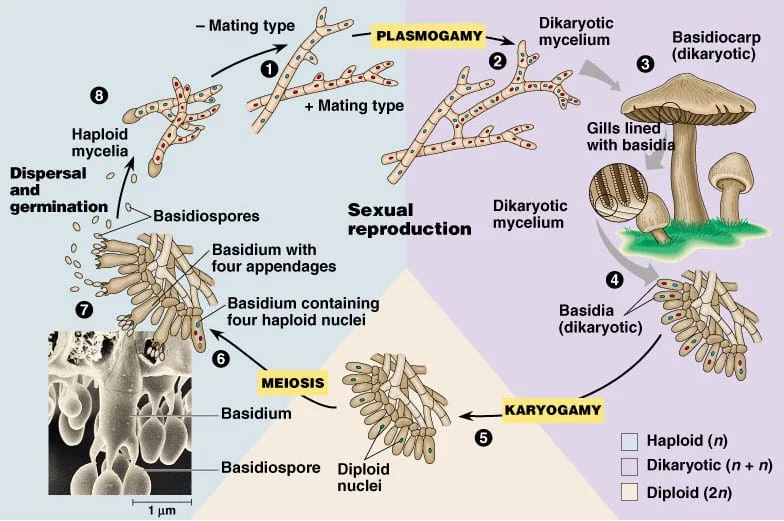OVERVIEW OF THE BASIDIOMYCETES FUNGI
In this artical we will be discussing the life cycle of mushrooms.
All gilled fungi are members of the class Basidiomycetes. They are characterized by the production of spores on club-shaped appendages called basidia. Spores borne on basidia are called basidiospores. Most of the conspicuous fungi that one encounters, such as mushrooms, puffballs and bracket fungi are members of the subclass Homobasidiomycetes. Of the members of this subclass the gilled mushrooms are placed in the order Agaricales.
The basidiospores germinate to form a monokaryotic hypha. A hypha is a tubular filament, an aggregation of these hyphae collectively comprise a mass of thread-like filaments referred to as the mycelium. The mycelium comprises the main body or thallus of the fungus.
The stalked capped structure which we call the mushroom is actually only the fruiting body, or the spore producing reproductive structure, and constitutes only a small portion of the total mass of the fungus. The great bulk of the organism exists underground in the form of a network of mycelium, which occasionally fruits or produces mushrooms under appropriate conditions.

INDEPTH OVERVIEW OF THE BASIDIOMYCETES FUNGI
MITOSIS
Mitosis is the process of one cell dividing into two daughters, such that each inherits a single and complete copy of the genome of their mother. This is achieved through the equal segregation of the sister chromatids between the daughter cells.
In multicellular fungi mitosis permits growth and repair of tissues.
In unicellular fungi mitosis is a form of as asexual reproduction.
So, the basidiospores will germinate to produce a monokaryotic mycelium, this is a mycelium having only one nucleus per cell. This monokaryotic mycelium will divide its cells through Mitosis, expanding and growing out until it encounters another monokaryotic mycelium germinated from another spore that is also a compatible mating type. If the monokaryotic mycelium does not contact a compatible monokaryotic mycelium, it eventually dies.
PLASMOGAMY
In situations where two compatible monokaryotic mycelia do make contact, a process called Plasmogamy takes place. Plasmogamy is the fusing of the somatic cells of the two mycelia, but not the fusion of the nuclei.
The result of Plasmogamy is the establishment of a dikaryotic mycelium. Dikaryotic mycelium possesses two nuclei, one from each of the monokaryotic mycelia in each of its cells. The dikaryotic mycelium stage is the most prolonged portion of the life cycle and is also the main assimilative stage of the fungus.
The dikaryotic mycelium can propagate vegetatively indefinitely without going through a sexual (spore-producing) stage.
PRODUCTION OF BASIDIOCARP
Given appropriate conditions, however, the dikaryotic mycelium can be induced to fruit. The undifferentiated mycelial thallus of the fungus begins to weave itself together into an articulated spore-bearing “fruiting body,” in this case, into a mushroom. The mushroom continues to enlarge and thrust above the ground, incorporating more and more mycelium while at the same time expanding by absorption of water.
KARYOGAMY
At a certain stage in the growth of the mushroom, or basidiocarp, club-shaped structures called basidia form on the underside of the gills. At this point, karyogamy takes place within the basidia. Karyogamy is the final step in the process of fusing together two haploid eukaryotic cells, and refers specifically to the fusion of the two nuclei. This is the only diploid, or 2n, stage in the life-cycle of the fungus.
MEIOSIS
The result of meiosis is the production of four haploid nuclei within the basidium; these are then pushed out of the basidium and become surrounded by hard sheaths to form the basidiospores. The result is the basidium bearing four basidiospores on its outer surface. These basidiospores eventually detach from the basidium to begin the life cycle again.
SPORE PROJECTION
Basidiomycetes that have spore baring surfaces that are open to the environment, have a discharge mechanism known as ballistospore.

These spores are connected to the basidia via cell projections called sterigma. The spores attached to the sterigma are shaped asymmetrically. There is a prominent bulge at the base of the spores called the Hilar appendix. Fluid aggregates in the Hilar appendix and on the side of the spore. We call the spherical droplet at the Hilar appendix the Bullers drop and the fluid on the side of the spore is the adaxial drop. The Bullers drop expands until it touches the adaxial drop, and the two fluid droplets fuse into one larger drop. At this moment, surface tension is released, and the spore is propelled off the sterigma into the environment. Hopefully that spore will find a suitable location to geminate, and the cycle will repeat.

